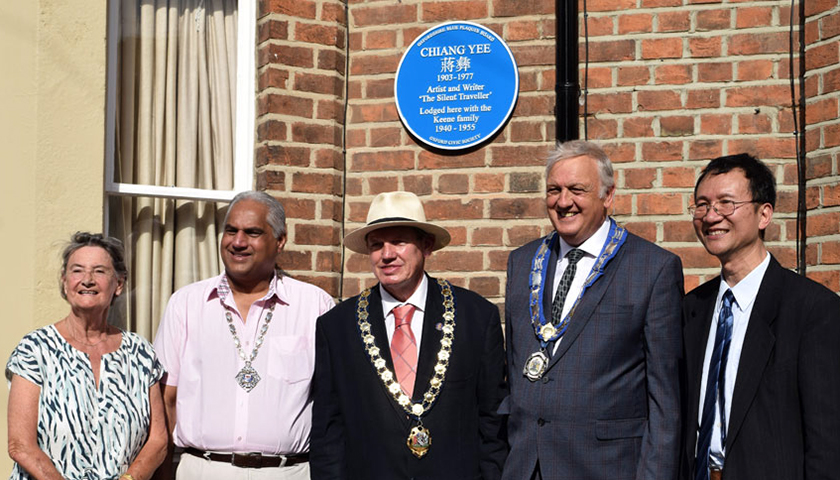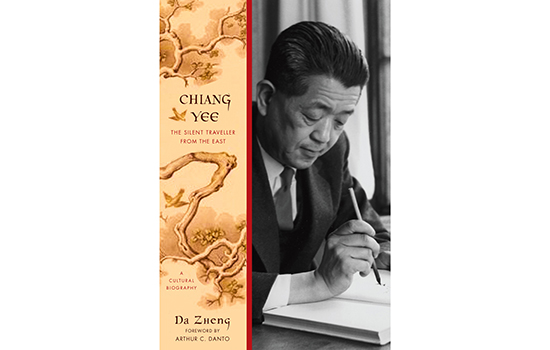English Professor Delivers Keynote as England Honors 'Silent Traveller'

Britain honored Chinese author-artist Chiang Yee in June with a special blue plaque unveiled by Suffolk English Professor Da Zheng at Yee’s longtime Oxford residence.
Yee left China for England in the 1930s, knowing very little English, but before long he became the popular author illustrator of the “Silent Traveller” series of books relating his observations of England, the United States—including Boston, France, Japan, and Australia.
Zheng, author of the award-winning Chiang Yee: The Silent Traveller from the East—A Cultural Biography, delivered the keynote speech at a symposium held in conjunction with the Oxfordshire Blue Plaques Board’s installation at 28 Southmoor Road, where Chiang Yee lived from 1940-1955.
The symposium at Ashmolean Museum was organized by Anne Witchard of the University of Westminster and attracted many people from Britain and beyond.
The text of Zheng’s speech follows.

The Silent Traveller at Home
On the occasion of the blue plaque unveiling, 28 Southmoor Road, Oxford, June 29, 2019.
About two decades ago, I came and knocked on the front door of 28 Southmoor Road. It was in the evening, dark and quiet in the neighborhood. As I was the only person in the surrounding area, I felt quite uncomfortable because I was almost certain that whoever answered the door would be surprised to find outside in front of the house a Chinese stranger (I was a little younger at the time). Who is he? Why is he here? What does he want? Soon someone did open the door. If there was initial surprise when he saw me, it dissipated instantaneously. After I introduced myself, he warmly welcomed me, invited me in, got me seated, and we began to chat.
I was working on the biography of Chiang Yee at the time. I attempted to trace Chiang Yee’s footsteps in the U.K. To record and understand his life experiences at 28 Southmoor Road was an important part because it had been his residence for 15 years. I told the hosts Richard and Pauline Jones about my research and about Chiang Yee. Surely, they listened with great interest. And they kindly told me about the history of the house and its layout before a major renovation, and we talked about the front part where Chiang Yee used to live. In short, the visit to the house helped me gain some new perspectives and understanding about Chiang Yee and his life. I felt really pleased.
It was a beautiful evening. I remember that, when I was on my way back to the hotel after the visit, I thought to myself: “How lucky I am to have been so kindly received! It must have been fate.”
I don’t believe in fate. But occasionally, I have to succumb myself to the notion of fate. As Chiang Yee once marveled at “the force of fate”: “life is a riddle.”
Indeed, life is full of mysterious coincidences: Chiang Yee knocked on the same door over 60 years earlier!
Chiang Yee grew up in China. After graduation from college, he served in the army briefly and had a short political experience as county magistrate. He was very disappointed and disillusioned with the rampant corruption and dirty politics in China, where the socio-political situation was very turbulent at the time. Japan had invaded northeastern provinces in China, and the civil war was raging on, that is, the clashes between the Chiang Kai-shek Nationalist army and the Communist forces. Chiang Yee made a pen-name for himself: “Silent Traveller.” He wanted to travel all over the world, observing without much talking.
In 1933, Chiang Yee came to England, searching for ways to help modernize China. Though he only knew a handful of English words, in just a few years, through his diligence and with the help and support of English friends, he gained a foothold in the literary and art circles as a burgeoning travel writer and artist. He published books about Chinese Art, Chinese Calligraphy, as well as Silent Traveller books in Lake District and London.
Chiang Yee did not expect that his artistic and literary career would be interrupted by WWII. On September 7, 1940, a year after the British government declared war, Germany launched the Blitz attack on London. Chiang Yee’s residence in Hampstead was hit by a bomb. Fortunately, he survived, as he was in Oxford that night, giving a speech on Chinese art at the Chinese Society.
Since London was no longer safe to stay, he came to Oxford, attempting to find a temporary place to stay for one night. He knocked on doors one after another. At 28 Southmoor, Henry and Violet Keene, who were living with their three-year-old daughter Rita, graciously welcomed this Chinese stranger to stay overnight. Chiang Yee returned the next day. And his stay extended for two weeks, and it eventually lasted fifteen years!
It is said that, if one survives a great disaster, good fortune is bound to follow. That was exactly what happened in Chiang Yee’s case. The disaster of the London Blitz led him to Oxford and ushered him into productive years between 1940 and 1955 in this wonderful city.
The new home was like a safe haven, where Chiang Yee was able to concentrate on his writing and painting. Even though he was perpetually worried and concerned about his family and hometown in China, the Keene family offered him such sincere and genuine love that was exceptionally soothing and comfortable. It became his home where he enjoyed warmth, kindness, and peace. It was here that he wrote and published five Silent Traveller titles, including those in Yorkshire Dales, Oxford, Edinburgh, New York, and Dublin, five children’s books, a novel, as well as several other books, articles, artworks, and stage and costume designs for stage productions. It was here that he received many friends, both Chinese and Western. He became a member of the Keene family, and Rita fondly called him Uncle. Whenever he traveled, to other cities or to other parts of the world, he knew that there was a home in Oxford where he could return.
Chiang Yee believed that, despite different cultural practices, skin colors, religious beliefs, and historical backgrounds, human beings share fundamental values. Through his travel writings, he takes the reader to perceive, underneath superficial differences, those commonalities among all people over the world.
Chiang Yee had successfully introduced Chinese culture, history, and art to the West; he also brought London, Oxford, Edinburgh, Lake District, and Yorkshire Dales to many other parts of the world, including China. He was forever grateful to have been generously appreciated and accepted by the people here in the U.K., and he has considered this as his second home.
Chiang Yee never would have predicted that over four decades after his passing, a Blue Plaque would be placed at his former residence in recognition of his literary and artistic contributions. As a Silent Traveller, who dedicated a large part of his life to cross-cultural exchanges and understandings, he would surely be thrilled to receive this honorable recognition, and to know that he would be permanently associated with the house and became part of this beautiful city of Oxford. He would smile, with a twinkle in his eyes, and remark joyfully, “Life is a riddle.”
In the Media
The Guardian: Blue plaque for the Chinese travel writer who won the heart of 1930s Britain
South China Morning Post: Chinese artist and author Chiang Yee takes rightful place in British cultural history
That’s magazine: Chinese Artist Chiang Yee Honored with Blue Plaque in Oxford
Oxford Mail: Jericho house where Chinese author Chiang Yee given refuge gets blue plaque
Contact
Greg Gatlin
Office of Public Affairs
617-573-8428



